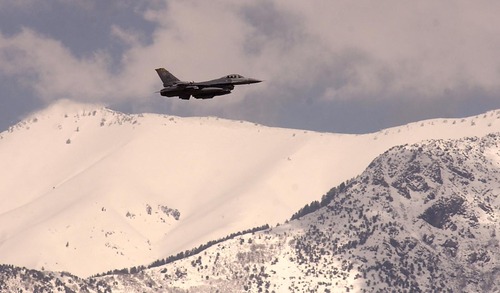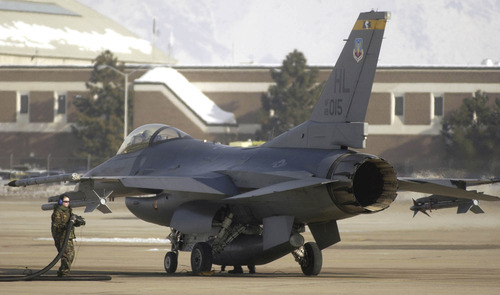This is an archived article that was published on sltrib.com in 2013, and information in the article may be outdated. It is provided only for personal research purposes and may not be reprinted.
Hill Air Force Base's 4th Fighter Squadron is preparing to get back in the air now that the military has reshuffled its spending priorities to get its pilots additional training.
The squadron has been grounded since April due to budget cuts affecting about one-third of active-duty combat craft, including squadrons of fighters, bombers and airborne warning and control craft, the Associated Press reported.
The 4th was the only squadron put on standdown.
The 4th flies about 24 F-16 fighters and crews have been doing ground training, flight simulations and routine maintenance, spokeswoman Andrea Mason said Monday. It will take about three months — the same amount of time it's been grounded — to be completely ready to fly again.
Officials at Air Combat Command at Joint Base Langley-Eustis in Virginia said the order affects planes in the U.S., Europe and the Pacific.
"Since April we've been in a precipitous decline with regard to combat readiness," Gen. Mike Hostage, commander of Air Combat Command, said in a statement. "Returning to flying is an important first step but what we have ahead of us is a measured climb to recovery."
The Air Force has said it generally takes 60 to 90 days to conduct the training needed to return air crews to mission-ready status. For the past several months, many pilots have been using simulators to try to keep their skills sharp.
The restoration of flying hours will last through Oct. 1, when the new federal budget year begins.
In the U.S., the affected aircraft were stationed at bases in Alaska, Arizona, Idaho, Nevada, North Carolina, Oklahoma, South Carolina, South Dakota, Utah and Virginia.
The popular Thunderbirds demonstration team comprised of F-16s also will resume training flights, but all 2013 shows will remain canceled, said Lt. Col. Tadd Sholtis, an Air Combat Command spokesman.
The ability for the Air Force to get its planes airborne again comes after the Defense Department was authorized by Congress to shift about $7.5 billion from lower -priority accounts to more vital operations. The Air Force said the restored flying hours represent about $208 million of that allocation authorized by Congress. In part, that funding comes from reducing spending on modernizing the fleet.
Some Republicans applauded the move by the Air Force while accusing the president of playing politics with the defense budget.
"If recent reprogramming measures can put our pilots back in the air, I fully expect the Air Force can also find a way to also end furloughs for this fiscal year," U.S. Sen. Jim Inhofe, R-Okla., said in a statement. "Today's announcement proves the military's pain from sequester could have been mitigated all along had my bill to give flexibility to the Department of Defense been rightfully considered."
"This decision gets us through the next several months but not the next several years," Hostage said. "Budget uncertainly makes it difficult to determine whether we'll be able to sustain a fully combat-ready force."





